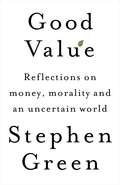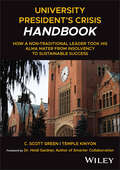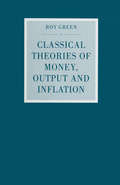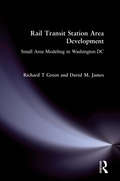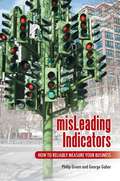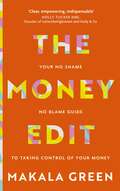- Table View
- List View
Involving People in Healthcare Policy and Practice
by Susie GreenThis book explores the link between the ‘corridors of power’ where healthcare policy is made and the hospital, health center or clinic where it is carried out. It encourages and empowers readers to make changes in the public’s involvement at a local level and explains how this impacts positively on organizational culture. A user-friendly book written in a light and easy-to-read style, it combines theoretical arguments with tried and tested practical applications and features contributions from a wide range of experienced professionals. This is essential reading for every member of the healthcare team. It will be of particular interest to patient and public involvement leads as well as patient advice and liaison service workers, healthcare policy makers and shapers, students and patient groups.
Making Sense of Construction Improvement
by Stuart GreenMaking Sense of Construction Improvement provides a critical evaluation of the construction improvement debate from the end of the Second World War through to the modern era. The book offers unique insights into the way the UK construction sector is continuously shaped and re-shaped in accordance with changes in the prevailing political economy. This second edition brings the book up to date by including coverage of key trends from 2010–2023. The book has been substantially revised and reworked to include new material relating to the ‘age of austerity’ and the subsequent period of political uncertainty initiated by the Brexit referendum. Changes in the political economy are positioned alongside the rise of the sustainability agenda and the advent of ‘zero carbon’. Particular attention is paid to the ongoing skills crisis and the over-hyped advocacy of modern methods of construction (MMC) as the latest supposed panacea of industry improvement. Coverage includes the Farmer (2016) report Modernise or Die and the Construction Playbook (HM Government, 2020). However, perhaps the most important addition is a focus on the Grenfell Disaster (2017) and the subsequent revelations from the public enquiry. Further intermediate milestones include Building a Safer Future (Hackitt, 2018) and the Construction Sector Deal (HM Government, 2018). The emerging consensus points towards a systemic failure involving not only the construction sector but also the entire system of regulation and compliance. Tracing the failings back over time and scrutinising the role played by previous generations of policymakers, Stuart Green ultimately argues that Grenfell was a disaster entirely foretold. The insightful and critical analysis of the industry contained within these pages is essential and timely reading for anyone who wants to understand how the construction sector arrived at where it is today, and with that knowledge, give further thought to where it might go next.
Making Sense of Construction Improvement
by Stuart GreenMaking Sense of Construction Improvement provides a critical evaluation of the construction improvement debate from the end of the Second World War through to the modern era. The book offers unique insights into the way the UK construction sector is continuously shaped and re-shaped in accordance with changes in the prevailing political economy. This second edition brings the book up to date by including coverage of key trends from 2010–2023. The book has been substantially revised and reworked to include new material relating to the ‘age of austerity’ and the subsequent period of political uncertainty initiated by the Brexit referendum. Changes in the political economy are positioned alongside the rise of the sustainability agenda and the advent of ‘zero carbon’. Particular attention is paid to the ongoing skills crisis and the over-hyped advocacy of modern methods of construction (MMC) as the latest supposed panacea of industry improvement. Coverage includes the Farmer (2016) report Modernise or Die and the Construction Playbook (HM Government, 2020). However, perhaps the most important addition is a focus on the Grenfell Disaster (2017) and the subsequent revelations from the public enquiry. Further intermediate milestones include Building a Safer Future (Hackitt, 2018) and the Construction Sector Deal (HM Government, 2018). The emerging consensus points towards a systemic failure involving not only the construction sector but also the entire system of regulation and compliance. Tracing the failings back over time and scrutinising the role played by previous generations of policymakers, Stuart Green ultimately argues that Grenfell was a disaster entirely foretold. The insightful and critical analysis of the industry contained within these pages is essential and timely reading for anyone who wants to understand how the construction sector arrived at where it is today, and with that knowledge, give further thought to where it might go next.
Good Value: Reflections on money, morality and an uncertain world
by Stephen GreenHow should we create wealth in societies, and why is it necessary to do so? What improves the lives of the largest number of people? And how do we, living in a globalised world caught in an age of financial and ecological turbulence, respond to the differing needs of individuals and institutions? Stephen Green, Chairman of HSBC, reflects on how the human desires for exploration and exchange have led us into a globalised, urban world, and considers why it is that capitalism is the best system by which to improve material human wealth. As the world's financial order is in a state of flux, how do we align these drives, and capitalism, with our spiritual and psychological needs? And how should the financial sector respond not only to the current crisis but to the wider needs of the people it serves. Do businesses - and banks in particular - have a duty to society that goes beyond the creation of profit? Does open market capitalism remain our best hope for creating wealth that benefits all of society? Encompassing history, politics, religion and economics, Good Value offers new perspectives on how we can live in a richer, more dynamic world.
Culture Hacker: Reprogramming Your Employee Experience to Improve Customer Service, Retention, and Performance
by Shane GreenHACK YOUR WORKPLACE CULTURE FOR GREATER PROFITS AND PRODUCTIVITY "I LOVE THIS BOOK!"—CHESTER ELTON, New York Times bestselling author of All In and What Motivates Me "When companies focus on culture, the positive effects ripple outward, benefiting not just employees but customers and profits. Read this smart, engaging book if you want a practical guide to getting those results for your organization."—MARSHALL GOLDSMITH, executive coach and New York Times bestselling author "Most books on customer service and experience ask leaders to focus on the customer first. Shane turns this notion on its head and makes a compelling case why leaders need to make 'satisfied employees' the priority."—LISA BODELL, CEO of Futurethink and author of Why Simple Wins "This is a must read for anyone in a customer service-centric industry. Shane explains the path to creating both satisfied customers and satisfied employees."—CHIP CONLEY, New York Times bestselling author and hospitality entrepreneur The question is not, "does your company have a culture?" The question is, "does your company have a culture that fosters outstanding customer experiences, limits employee turnover, and ensures high performance?" Every executive and manager has a responsibility to positively influence their workplace culture. Culture Hacker gives you the tools and insights to do it with simplicity and style. Culture Hacker explains: Twelve high-impact hacks to improve employee experience and performance How to delight and retain a multi-generational workforce The factors determining whether or not your employees deliver outstanding customer service
Culture Hacker: Reprogramming Your Employee Experience to Improve Customer Service, Retention, and Performance
by Shane GreenHACK YOUR WORKPLACE CULTURE FOR GREATER PROFITS AND PRODUCTIVITY "I LOVE THIS BOOK!"—CHESTER ELTON, New York Times bestselling author of All In and What Motivates Me "When companies focus on culture, the positive effects ripple outward, benefiting not just employees but customers and profits. Read this smart, engaging book if you want a practical guide to getting those results for your organization."—MARSHALL GOLDSMITH, executive coach and New York Times bestselling author "Most books on customer service and experience ask leaders to focus on the customer first. Shane turns this notion on its head and makes a compelling case why leaders need to make 'satisfied employees' the priority."—LISA BODELL, CEO of Futurethink and author of Why Simple Wins "This is a must read for anyone in a customer service-centric industry. Shane explains the path to creating both satisfied customers and satisfied employees."—CHIP CONLEY, New York Times bestselling author and hospitality entrepreneur The question is not, "does your company have a culture?" The question is, "does your company have a culture that fosters outstanding customer experiences, limits employee turnover, and ensures high performance?" Every executive and manager has a responsibility to positively influence their workplace culture. Culture Hacker gives you the tools and insights to do it with simplicity and style. Culture Hacker explains: Twelve high-impact hacks to improve employee experience and performance How to delight and retain a multi-generational workforce The factors determining whether or not your employees deliver outstanding customer service
University President's Crisis Handbook: How a Non-Traditional Leader Took His Alma Mater from Insolvency to Sustainable Success
by Scott Green Temple KinyonDiscover the non-traditional leadership techniques that took the University of Idaho from insolvency to international renown In University President’s Crisis Handbook, the President of the University of Idaho, C. Scott Green, and author Temple Kinyon deliver a one-of-a-kind perspective on managing universities through periods of intense turmoil and difficulty. The book offers in-depth managerial insights into the three strategic pillars and industry expert guidance that helped Green shepherd the University of Idaho through years of deep deficits and the COVID-19 pandemic. You’ll find comprehensive discussions of how the university achieved financial solvency, soaring enrollments, record research awards, and record fundraising amid extraordinary challenges. You’ll also discover: Explorations of the strategic touchstones leading to U of I’s transformation: student success, pursuit of R1 Carnegie research classification leading to soaring grant awards, and narrative control How the university and its community supported itself in the face of a tragic and outrageous crime against 4 of its students The strategies used by the university and its faculty to safely reopen the school after lengthy closures in the middle of the COVID-19 pandemic Perfect for university administrators, University President’s Crisis Handbook will also prove invaluable to academics with leadership responsibilities and managers, executives, board members and other leaders in the public and private sectors.
University President's Crisis Handbook: How a Non-Traditional Leader Took His Alma Mater from Insolvency to Sustainable Success
by Scott Green Temple KinyonDiscover the non-traditional leadership techniques that took the University of Idaho from insolvency to international renown In University President’s Crisis Handbook, the President of the University of Idaho, C. Scott Green, and author Temple Kinyon deliver a one-of-a-kind perspective on managing universities through periods of intense turmoil and difficulty. The book offers in-depth managerial insights into the three strategic pillars and industry expert guidance that helped Green shepherd the University of Idaho through years of deep deficits and the COVID-19 pandemic. You’ll find comprehensive discussions of how the university achieved financial solvency, soaring enrollments, record research awards, and record fundraising amid extraordinary challenges. You’ll also discover: Explorations of the strategic touchstones leading to U of I’s transformation: student success, pursuit of R1 Carnegie research classification leading to soaring grant awards, and narrative control How the university and its community supported itself in the face of a tragic and outrageous crime against 4 of its students The strategies used by the university and its faculty to safely reopen the school after lengthy closures in the middle of the COVID-19 pandemic Perfect for university administrators, University President’s Crisis Handbook will also prove invaluable to academics with leadership responsibilities and managers, executives, board members and other leaders in the public and private sectors.
Sarbanes-Oxley and the Board of Directors: Techniques and Best Practices for Corporate Governance
by Scott GreenSarbanes-Oxley and the Board of Directors is a practical, down-to-earth guide for board members. It covers everything from board basics to compliance with regulations, corporate culture and values to assessing and reacting to hostile shareholder activities. Complete with real-world examples, vignettes, case studies, and other information, this guide helps board members, CEOs, CFOs, and others understand their responsibilities and potential liabilities and implement effective corporate governance. It covers building a strong framework for effective governance, ways to protect board members, specific guidance for effective corporate oversight and communications, and more. Sarbanes-Oxley and the Board of Directors gives directors the knowledge, techniques, and tools to serve the company and its stockholders well.
Classical Theories of Money, Output and Inflation: A Study in Historical Economics (Studies in Political Economy)
by Roy GreenThis book challenges the conventional view that monetarism is a necessary part of classical economics and shows, in an historical account of monetary controversy, that the framework upon which classical analysis is based suggests an alternative account of the inflationary process. A corollary of the argument is that the monetarist approach is a logically necessary component of neoclassical analysis and that any attempt to criticise that approach in a fundamental way must involve an explicit rejection of the conceptual structure of neoclassical economics.
Architect's Guide to Running a Job
by Ronald GreenBest practice is the concern of this book. An architect has to be an administrator as well as designer, and smooth economical administration will provide the conditions under which client relations can be constructive and good design can be acheived.The book is divided into 76 short sections covering the entire process, from preliminary enquiries to final fees, each with a small flow chart showing who is involved and when. This sixth revised edition updates the contents in line with present day practice, bearing in mind the changes in terminology, technology, environmental demands and the legislative background.Ronald Green and Professor Ross Jamieson who writes the foreword to this edition, are both examiners for Part Three.
Architect's Guide to Running a Job
by Ronald GreenBest practice is the concern of this book. An architect has to be an administrator as well as designer, and smooth economical administration will provide the conditions under which client relations can be constructive and good design can be acheived.The book is divided into 76 short sections covering the entire process, from preliminary enquiries to final fees, each with a small flow chart showing who is involved and when. This sixth revised edition updates the contents in line with present day practice, bearing in mind the changes in terminology, technology, environmental demands and the legislative background.Ronald Green and Professor Ross Jamieson who writes the foreword to this edition, are both examiners for Part Three.
Rail Transit Station Area Development: Small Area Modeling in Washington DC
by Richard T Green David M. JamesA study of past and prospective business development around rail transit stations in the Washington DC area. Washington has one of the very few new and extensive rail transit systems in America, although expectations of transit system-induced revitalization in this area have not uniformly been met. This book develops an econometric model of local development (LOCDEV) around major public investments, applies it to the existing Washington transit system, and uses it to forecast future development levels around new stations. The book includes a user's guide to the LOCDEV model and concludes with reflections on modelling and forecasting.
Rail Transit Station Area Development: Small Area Modeling in Washington DC
by Richard T Green David M. JamesA study of past and prospective business development around rail transit stations in the Washington DC area. Washington has one of the very few new and extensive rail transit systems in America, although expectations of transit system-induced revitalization in this area have not uniformly been met. This book develops an econometric model of local development (LOCDEV) around major public investments, applies it to the existing Washington transit system, and uses it to forecast future development levels around new stations. The book includes a user's guide to the LOCDEV model and concludes with reflections on modelling and forecasting.
Introduction to Mortgages and Mortgage Backed Securities
by Richard K. GreenIn Introduction to Mortgages & Mortgage Backed Securities, author Richard Green combines current practices in real estate capital markets with financial theory so readers can make intelligent business decisions. After a behavioral economics chapter on the nature of real estate decisions, he explores mortgage products, processes, derivatives, and international practices. By focusing on debt, his book presents a different view of the mortgage market than is commonly available, and his primer on fixed-income tools and concepts ensures that readers understand the rich content he covers. Including commercial and residential real estate, this book explains how the markets work, why they collapsed in 2008, and what countries are doing to protect themselves from future bubbles. Green's expertise illuminates both the fundamentals of mortgage analysis and the international paradigms of products, models, and regulatory environments. Written for buyers of real estate, not mortgage lenders Balances theory with increasingly complex practices of commercial and residential mortgage lendingEmphasizes international practices, changes caused by the 2008-11 financial crisis, and the behavioral aspects of mortgage decision making
misLeading Indicators: How to Reliably Measure Your Business
by Philip Green George GaborThis book reveals the hidden and potentially misleading nature of measurements, empowering readers to avoid making critical business decisions that are harmful, unreasonable, unwarranted, or plain wrong.Decision makers in business and government are more reliant than ever on measurements, such as business performance indicators, bond ratings, Six-Sigma indicators, stock ratings, opinion polls, and market research. Yet many popular statistical and business books and courses relating to measurement are based on flawed principles, leading managers to the wrong conclusions—and ultimately, the wrong decisions. misLeading Indicators: How to Reliably Measure Your Business provides something unique and invaluable: trustworthy tools for judging measurements.Each chapter illustrates the four key principles for reliable measurements: sufficient background information, accuracy and precision, reasonable inferences, and reality checks in different situations. After the three fundamental methods of measuring are defined, the authors expand to the application and interpretation of measurements in specific areas, including business performance, risk management, process, control, finance, and economics. This book supplies essential information for managers in business and government who depend on accurate information to run their organizations, as well as the consultants who advise them.
misLeading Indicators: How to Reliably Measure Your Business
by Philip Green George GaborThis book reveals the hidden and potentially misleading nature of measurements, empowering readers to avoid making critical business decisions that are harmful, unreasonable, unwarranted, or plain wrong.Decision makers in business and government are more reliant than ever on measurements, such as business performance indicators, bond ratings, Six-Sigma indicators, stock ratings, opinion polls, and market research. Yet many popular statistical and business books and courses relating to measurement are based on flawed principles, leading managers to the wrong conclusions—and ultimately, the wrong decisions. misLeading Indicators: How to Reliably Measure Your Business provides something unique and invaluable: trustworthy tools for judging measurements.Each chapter illustrates the four key principles for reliable measurements: sufficient background information, accuracy and precision, reasonable inferences, and reality checks in different situations. After the three fundamental methods of measuring are defined, the authors expand to the application and interpretation of measurements in specific areas, including business performance, risk management, process, control, finance, and economics. This book supplies essential information for managers in business and government who depend on accurate information to run their organizations, as well as the consultants who advise them.
Enterprise Risk Management: A Common Framework for the Entire Organization
by Philip E. GreenEnterprise Risk Management: A Common Framework for the Entire Organization discusses the many types of risks all businesses face. It reviews various categories of risk, including financial, cyber, health, safety and environmental, brand, supply chain, political, and strategic risks and many others. It provides a common framework and terminology for managing these risks to build an effective enterprise risk management system. This enables companies to prevent major risk events, detect them when they happen, and to respond quickly, appropriately, and resiliently. The book solves the problem of differing strategies, techniques, and terminology within an organization and between different risk specialties by presenting the core principles common to managing all types of risks, while also showing how these principles apply to physical, financial, brand, and global strategy risks. Enterprise Risk Management is ideal for executives and managers across the entire organization, providing the comprehensive understanding they need, in everyday language, to successfully navigate, manage, and mitigate the complex risks they face in today’s global market. Provides a framework on which to build an enterprise-wide system to manage risk and potential losses in business settingsSolves the problem of differing strategies, techniques, and terminology within an organization by presenting the core principles common to managing all types of risksOffers principles which apply to physical, financial, brand, and global strategy risksPresents useful, building block information in everyday language for both managers and risk practitioners across the entire organization
Management Scholarship and Organisational Change: Representing Burns and Stalker (Finance, Governance and Sustainability)
by Miriam GreenChange is a crucial and inescapable process for many organisations. It remains a constant challenge for managers and many change management initiatives fail. Burns and Stalker’s seminal text on managing change, The Management of Innovation, has often been used as a basis for research in mainstream management journals and has been represented as an important theory in popular and long-established management textbooks. The issues raised in that book are still being grappled with by academics and practitioners today. Miriam Green provides a critical analysis of the mainstream construction of knowledge on change management through an examination of representations of that text. The main thesis of her book is that this literature, though valuable, does not provide a full picture. Its objectivist approach ignores the role of other factors raised in the original study. These factors include the effects of power, politics, resistance and employee influence on the outcomes of managerial change strategies and on other organisational processes, with important consequences for the understanding of change initiatives by both academics and practitioners. This is part of an ongoing debate in management studies and more widely in the social sciences about theoretical approaches and research methods. The originality of this book lies in its in-depth comparison of an entire monograph on organisations facing technological and commercial change, with an equally in-depth analysis of the ways this work has been represented and used as a basis for teaching and research. It highlights the limitations of the exclusive use of one approach to explain the complications arising from organisational change. It challenges the scientific justification offered for that approach and supports arguments for more inclusive and sustainable scholarship, of greater relevance to academics, managers and other organisational stakeholders.
Management Scholarship and Organisational Change: Representing Burns and Stalker (Finance, Governance and Sustainability)
by Miriam GreenChange is a crucial and inescapable process for many organisations. It remains a constant challenge for managers and many change management initiatives fail. Burns and Stalker’s seminal text on managing change, The Management of Innovation, has often been used as a basis for research in mainstream management journals and has been represented as an important theory in popular and long-established management textbooks. The issues raised in that book are still being grappled with by academics and practitioners today. Miriam Green provides a critical analysis of the mainstream construction of knowledge on change management through an examination of representations of that text. The main thesis of her book is that this literature, though valuable, does not provide a full picture. Its objectivist approach ignores the role of other factors raised in the original study. These factors include the effects of power, politics, resistance and employee influence on the outcomes of managerial change strategies and on other organisational processes, with important consequences for the understanding of change initiatives by both academics and practitioners. This is part of an ongoing debate in management studies and more widely in the social sciences about theoretical approaches and research methods. The originality of this book lies in its in-depth comparison of an entire monograph on organisations facing technological and commercial change, with an equally in-depth analysis of the ways this work has been represented and used as a basis for teaching and research. It highlights the limitations of the exclusive use of one approach to explain the complications arising from organisational change. It challenges the scientific justification offered for that approach and supports arguments for more inclusive and sustainable scholarship, of greater relevance to academics, managers and other organisational stakeholders.
Elite Sport Development: Policy Learning and Political Priorities
by Mick Green Barrie HoulihanElite Sport Development addresses important sport policy questions and explores the emergence, development and current status of elite sport development policy with detailed examination of Australia, Canada and the UK. The sports compared are swimming, track and field athletics, and sailing. The book looks at the problems faced in establishing an elite sport development infrastructure covering facilities, coaching, sports science and competition. Likewise, full-time athletes are considered and the tensions that a pre-occupation with elite achievement generates within the sports is also examined. Includes: * why governments invest heavily in elite sport* the relationship between Government and NGB's* the impact of elite investment on 'sport for all' * the selection of individual sports for priority funding. This detailed text will be of interest to students, researchers and professionals working in sports development and policy.
Elite Sport Development: Policy Learning and Political Priorities
by Mick Green Barrie HoulihanElite Sport Development addresses important sport policy questions and explores the emergence, development and current status of elite sport development policy with detailed examination of Australia, Canada and the UK. The sports compared are swimming, track and field athletics, and sailing. The book looks at the problems faced in establishing an elite sport development infrastructure covering facilities, coaching, sports science and competition. Likewise, full-time athletes are considered and the tensions that a pre-occupation with elite achievement generates within the sports is also examined. Includes: * why governments invest heavily in elite sport* the relationship between Government and NGB's* the impact of elite investment on 'sport for all' * the selection of individual sports for priority funding. This detailed text will be of interest to students, researchers and professionals working in sports development and policy.
Painless Performance Conversations: A Practical Approach to Critical Day-to-Day Workplace Discussions
by Marnie E. GreenActionable communication and management strategies for tackling difficult workplace discussions Delivering the uncomfortable news that an employee is not stacking up can be stressful, and managers often have difficulties finding the right words to get their message across. Painless Performance Conversations presents actionable and practical communication and management strategies for any manager looking to effectively influence employee performance. Learn how to focus these conversations for maximum impact on performance, crystallize expectations for what success looks like, and engage employees in solution-finding. Presenting four key mindsets and an easy to use conversation model, this book offers the tangible solutions managers need to tackle critical workplace discussions with poise and professionalism, as well as the tools needed to stay focused in otherwise difficult conversations. Eliminates the pain and fear that leads to procrastination of tough workplace conversations. Reduces the harmful impacts of judgment in performance conversation Helps managers create a culture of ownership and accountability Author Marnie E. Green is a featured blogger for Jobing.com and shares her popular and practical management perspectives in keynotes, webinars, and workshops with thousands of leaders in organizations worldwide Painless Performance Conversations will help you to lead performance-related conversations with confidence and create a culture of workplace accountability.
Painless Performance Conversations: A Practical Approach to Critical Day-to-Day Workplace Discussions
by Marnie E. GreenActionable communication and management strategies for tackling difficult workplace discussions Delivering the uncomfortable news that an employee is not stacking up can be stressful, and managers often have difficulties finding the right words to get their message across. Painless Performance Conversations presents actionable and practical communication and management strategies for any manager looking to effectively influence employee performance. Learn how to focus these conversations for maximum impact on performance, crystallize expectations for what success looks like, and engage employees in solution-finding. Presenting four key mindsets and an easy to use conversation model, this book offers the tangible solutions managers need to tackle critical workplace discussions with poise and professionalism, as well as the tools needed to stay focused in otherwise difficult conversations. Eliminates the pain and fear that leads to procrastination of tough workplace conversations. Reduces the harmful impacts of judgment in performance conversation Helps managers create a culture of ownership and accountability Author Marnie E. Green is a featured blogger for Jobing.com and shares her popular and practical management perspectives in keynotes, webinars, and workshops with thousands of leaders in organizations worldwide Painless Performance Conversations will help you to lead performance-related conversations with confidence and create a culture of workplace accountability.
The Money Edit: Your no blame, no shame guide to taking control of your money
by Makala GreenMoney is a foundation of life, it impacts almost all of our choices, whether it's what to have for lunch or when we will retire - so why don't we like talking about it? Money is complicated, or at least it seems complicated. From ISAs to pensions and debt to tax, money management feels like a mine-field, but it doesn't need to be. Makala Green, a financial expert, The UK's first black female chartered financial expert, a businesswoman and a speaker and wealth coach with over 17 years' experience has spent years learning about the different aspects of the financial world. Here, she shares all her knowledge to help us break down barriers and gain financial freedom.The Money Edit is a no-jargon, straight-talking guide, giving us the confidence and clarity to understand money and help us make the right choices - no matter what life stage we are at. Makala busts money-myth after myth and shows us how to:1. Cultivate a money mindset2. Address difficult conversations about money3. Track income and expenses and learn how to budget 4. Start saving and plan for the future 5. Get on the property ladder6. Adapt when financial circumstances change No matter your background, upbringing or circumstances, The Money Edit is a simple approach with plenty of real-life examples, checklists, planning tools and resources to get you started. Makala is here to make you feel positive, confident and in control when it comes to money.


